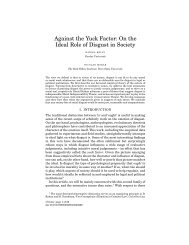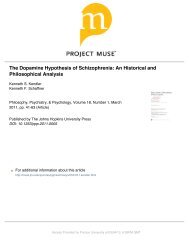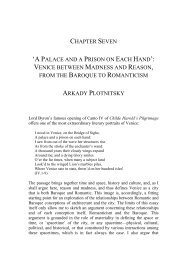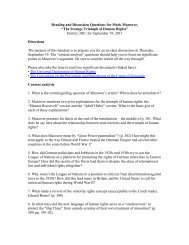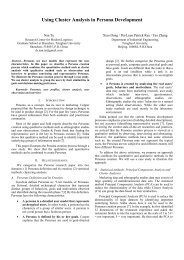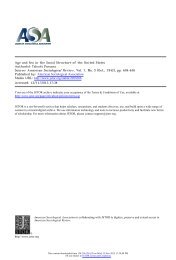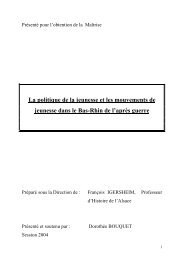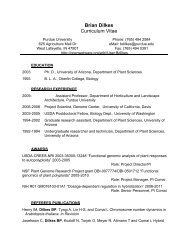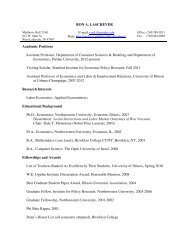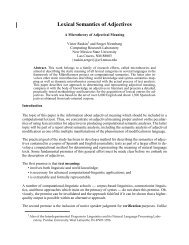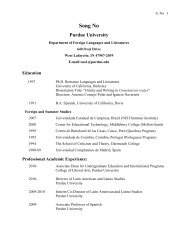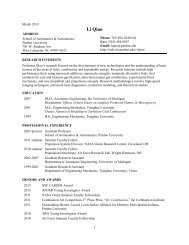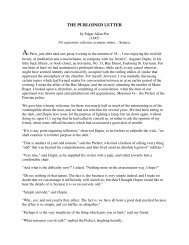A Short Course in Seismic Reflection Profiling VI ... - Purdue University
A Short Course in Seismic Reflection Profiling VI ... - Purdue University
A Short Course in Seismic Reflection Profiling VI ... - Purdue University
You also want an ePaper? Increase the reach of your titles
YUMPU automatically turns print PDFs into web optimized ePapers that Google loves.
A <strong>Short</strong> <strong>Course</strong> <strong>in</strong> <strong>Seismic</strong><br />
<strong>Reflection</strong> Profil<strong>in</strong>g<br />
Theory, Wave Propagation <strong>in</strong> Layered Media,<br />
Data Acquisition, Process<strong>in</strong>g, Interpretation<br />
Larry Braile<br />
Professor<br />
Earth and Atmospheric Sciences<br />
<strong>Purdue</strong> <strong>University</strong><br />
June, 2012<br />
braile@purdue.edu<br />
http://web.ics.purdue/~braile<br />
<strong>VI</strong>. E. Vibroseis<br />
Explor<strong>in</strong>g Planet Earth
A <strong>Short</strong> <strong>Course</strong> <strong>in</strong> <strong>Seismic</strong> <strong>Reflection</strong> Profil<strong>in</strong>g<br />
Theory, Wave Propagation <strong>in</strong> Layered Media, Data Acquisition,<br />
Process<strong>in</strong>g, Interpretation<br />
Prof. L. W. Braile<br />
Table of Contents<br />
I. Introduction<br />
II. Theory<br />
III. Rock Properties<br />
IV. Some Def<strong>in</strong>itions<br />
V. <strong>Seismic</strong> Data Acquisition<br />
<strong>VI</strong>. <strong>Seismic</strong> Data Process<strong>in</strong>g<br />
Understand<strong>in</strong>g Vibroseis Correlation<br />
<strong>VI</strong>I. <strong>Reflection</strong> Profil<strong>in</strong>g Interpretation – General Pr<strong>in</strong>ciples<br />
<strong>VI</strong>II. A Brief Look at Interpretation<br />
IX. A Few Useful References
<strong>VI</strong>. <strong>Seismic</strong> Data Process<strong>in</strong>g<br />
E. Vibroseis Correlation – An Example of<br />
Digital Signal Process<strong>in</strong>g
Vibroseis Correlation – An Example<br />
of Digital Signal Process<strong>in</strong>g<br />
Larry Braile<br />
Department of Earth and Atmospheric Sciences<br />
<strong>Purdue</strong> <strong>University</strong><br />
West Lafayette, IN 47907<br />
braile@purdue. edu<br />
http: //web. ics. purdue. edu/~braile<br />
URL for this file:<br />
http: //web. ics. purdue. edu/~braile/sage/<strong>Short</strong><strong>Course</strong>Notes. 6. A. Vibroseis. pdf
Understand<strong>in</strong>g Vibroseis Correlation –<br />
Significance and Audience<br />
An example of digital signal process<strong>in</strong>g and l<strong>in</strong>ear<br />
systems representation of seismograms.<br />
Vibroseis is an important and commonly used method<br />
for seismic reflection data acquisition.<br />
Most useful at the advanced undergraduate and<br />
graduate level (most effective for students with a<br />
basic understand<strong>in</strong>g of convolution and Fourier<br />
transforms).
Understand<strong>in</strong>g Vibroseis Correlation –<br />
Fundamental Concepts<br />
Illustrate time and frequency doma<strong>in</strong> content of signals.<br />
Example of time and frequency doma<strong>in</strong> representation and<br />
signal process<strong>in</strong>g.<br />
Illustration of amplitude and phase representation of the Fourier<br />
transform.<br />
Applications of the convolution theorem.<br />
Demonstration of the mean<strong>in</strong>g of the phase spectrum.<br />
Expla<strong>in</strong>s why the arrival time is at the center of the wavelet for<br />
Vibroseis seismograms.<br />
Expla<strong>in</strong>s how cross-correlation with the sweep collapses the<br />
sweep reflections <strong>in</strong>to wavelets.<br />
Illustrate w<strong>in</strong>dow<strong>in</strong>g, smooth<strong>in</strong>g and effect of truncation<br />
concepts.
A Sample Vibroseis Sweep<br />
The sample Vibroseis sweep (above) has relatively low<br />
frequencies and a limited frequency range so that the signals<br />
can be easily viewed <strong>in</strong> the follow<strong>in</strong>g illustrations. Typical<br />
exploration seismology Vibroseis sweeps are <strong>in</strong> the range of 8<br />
to 80 Hz. The sweep has s<strong>in</strong>usoidal character and beg<strong>in</strong>s with<br />
a frequency of 1 Hz and ends with a frequency of 5 Hz.
Effect of W<strong>in</strong>dow<strong>in</strong>g<br />
The <strong>in</strong>put sweep is commonly “w<strong>in</strong>dowed” (tapered at the ends as shown<br />
above) to reduce truncation effects (Gibbs phenomena) that produce<br />
sidelobes and a longer duration wavelet.
Vibroseis Schematic – Figure 1 (next slide and small image below) is a<br />
schematic illustration of how Vibroseis works. The data were calculated and<br />
plotted with a MATLAB code. The first trace (red) is the sample sweep after<br />
apply<strong>in</strong>g a w<strong>in</strong>dow to smoothly taper the sweep at the beg<strong>in</strong>n<strong>in</strong>g and end.<br />
The second trace (blue) is an Earth vertical <strong>in</strong>cidence reflection response<br />
from three <strong>in</strong>terfaces. The result<strong>in</strong>g response has three spikes (impulses)<br />
represent<strong>in</strong>g reflection coefficients. The spikes are located at the two-way<br />
travel times and are scaled <strong>in</strong> amplitude by the reflection coefficient. Note<br />
that spikes 1 and 3 are positive<br />
amplitude impulses and spike 2<br />
is a negative amplitude impulse.<br />
The next three traces (black)<br />
are the reflection responses to<br />
the downward travel<strong>in</strong>g source<br />
sweep. They are aligned <strong>in</strong><br />
time by the reflection travel<br />
times and are scaled by the<br />
spike amplitude (reflection<br />
coefficient). Note that the<br />
response for reflection 2 is<br />
phase reversed.
Vibroseis Schematic (cont<strong>in</strong>ued) – The sixth trace is the recorded<br />
seismogram (green, uncorrelated) and can be produced by summ<strong>in</strong>g the<br />
three reflection responses (black) or, equivalently, by convolv<strong>in</strong>g the source<br />
sweep (red) with the Earth response (blue). When Vibroseis data are<br />
collected and recorded from the geophones, the data <strong>in</strong>itially look similar to<br />
the uncorrelated seismogram shown <strong>in</strong> green. Note that the trace is long (<strong>in</strong><br />
this case 16 s) compared to the maximum two-way travel time of the target<br />
Earth model (<strong>in</strong> this case 7 seconds), and is very “r<strong>in</strong>gy” (s<strong>in</strong>usoidal<br />
character). The difference<br />
between the total record<strong>in</strong>g<br />
time and the sweep<br />
length is the “listen time.”<br />
The “trick” to Vibroseis is to<br />
cross-correlate the sweep with<br />
the uncorrelated seismogram.<br />
This process collapses the<br />
sweeps <strong>in</strong>to wavelets and<br />
reduces the length of the<br />
seismogram. The result<strong>in</strong>g<br />
seismogram is shown <strong>in</strong> the<br />
bottom trace (red).
Figure 1. Vibroseis Schematic (explanation on previous slides)<br />
After L<strong>in</strong>dseth, 1968
Figure 2. Vibroseis Schematic – Cross-Correlation<br />
Illustration of the cross-correlation process – position of one time lag of the pilot<br />
sweep (red) is shown below (on top of the green trace; all time lags are<br />
calculated as the pilot sweep moves from left to right over the uncorrelated<br />
seismogram; also see video and animation <strong>in</strong> PowerPo<strong>in</strong>t referenced below).<br />
At this position, the cross-correlation coefficient (the sum of the product of the<br />
two signals) is a maximum (the product of two positive parts of the signals is<br />
positive, and the product of two negative parts of the signals is also positive)<br />
and is plotted on the bottom red trace (the seismogram, s(t)) at the lag position<br />
shown by the th<strong>in</strong> vertical l<strong>in</strong>e. Note that the wavelet that is produced is<br />
symmetric and is centered on the two-way travel time for the reflections (1.5,<br />
3.5 and 7 s). The wavelets conta<strong>in</strong> the sweep frequencies (1 to 5 Hz energy).<br />
After L<strong>in</strong>dseth, 1968
Time and frequency doma<strong>in</strong> representation of Vibroseis<br />
data acquisition and correlation process<strong>in</strong>g: In the next two slides<br />
(small view of the first slide shown below), the vibroseis process is illustrated <strong>in</strong><br />
both the time and frequency doma<strong>in</strong>. The three columns illustrate the time<br />
doma<strong>in</strong> (red), frequency doma<strong>in</strong> amplitude spectrum (blue), and frequency<br />
doma<strong>in</strong> phase spectrum (green) for each step (rows) of the process.<br />
Figure 3a (1 st row) shows the pilot sweep <strong>in</strong> time and the amplitude and phase<br />
spectra. Note that the amplitude spectrum shows that the sweep conta<strong>in</strong>s<br />
energy from about 1 to 5 Hz and the “edges” of the spectrum are smooth due<br />
to the taper applied to the<br />
sweep. The slope of the phase<br />
spectrum is the delay of the<br />
frequencies show<strong>in</strong>g that the low<br />
frequencies are delayed a small<br />
amount and the higher<br />
frequencies are <strong>in</strong>creas<strong>in</strong>gly<br />
delayed.
Time and frequency doma<strong>in</strong> representation of Vibroseis<br />
data acquisition and correlation process<strong>in</strong>g (cont<strong>in</strong>ued): Figure<br />
3b (2 nd row) shows the time and frequency plots for the Earth response<br />
(reflections). Note that the phase spectrum has constant slope as the spikes<br />
conta<strong>in</strong> all frequencies and each spike is delayed <strong>in</strong> time.<br />
Figure 3c (3 rd row) is the result of convolution (<strong>in</strong> the time doma<strong>in</strong>) of the sweep<br />
and the Earth response which produces the uncorrelated seismogram shown<br />
<strong>in</strong> the lower left. The equivalent process <strong>in</strong> the frequency doma<strong>in</strong> is<br />
multiplication (the convolution theorem), which, for amplitude and phase<br />
spectra means multiply<strong>in</strong>g the<br />
amplitude spectra and add<strong>in</strong>g<br />
the phase spectra. Note that the<br />
phase spectrum of the uncorrelated<br />
seismogram (lower right)<br />
is curved but not equal to the<br />
phase spectrum of the sweep.
Time and frequency doma<strong>in</strong> representation of Vibroseis<br />
data acquisition and correlation process<strong>in</strong>g (cont<strong>in</strong>ued): Figure<br />
3d (1 st row) shows the time and frequency plots for the Earth uncorrelated<br />
seismogram, identical to Figure 3c. To process the uncorrelated seismogram,<br />
we cross-correlate with the sweep (shown <strong>in</strong> Figure 3e, 2 nd row). Note that <strong>in</strong><br />
the frequency doma<strong>in</strong>, cross-correlation is the same as multiply<strong>in</strong>g with the<br />
conjugate of the spectra (a corollary of the convolution theorem) which means<br />
multiply<strong>in</strong>g the amplitude spectra and add<strong>in</strong>g the negative of one of the phase<br />
spectrum to the other phase spectrum. In this process, the phase spectrum of<br />
the sweep (and associated<br />
delays <strong>in</strong> the time doma<strong>in</strong>)<br />
disappears and we are left<br />
with the phase spectrum of<br />
the Earth response. The<br />
result is shown <strong>in</strong> Figure 3f<br />
(3 rd row).
Figure 3a,b,c. Uncorrelated Seismogram – Time and Frequency
Figure 3d,e,f. Correlated Seismogram – Time and Frequency
Theory and Derivation<br />
Illustrated by Figure 1
Illustrated by Figure 3a,b,c<br />
Schematically illustrated<br />
<strong>in</strong> the time doma<strong>in</strong> <strong>in</strong><br />
Figure 2
Illustrated by Figure 3d,e,f
Illustrated by Figure 3f<br />
The follow<strong>in</strong>g two slides are Figure 3a,b,c and<br />
Figure 3d,e,f <strong>in</strong> expanded view.
Figure 3a,b,c. Uncorrelated Seismogram – Time and Frequency
Figure 3d,e,f. Correlated Seismogram – Time and Frequency
The Vibroseis Method: The Vibroseis method has a number of<br />
advantages related to the truck mounted source and long sweep (many<br />
seconds). Substantial energy can be put <strong>in</strong>to the ground with the long<br />
sweep, multiple sources (trucks), and repeated sweeps (stacked). The<br />
Vibroseis sweep can be designed and controlled, and it is a mobile and<br />
repeatable source. Because the energy is distributed over time,<br />
environmental effects are reduced. Cross-correlation is a powerful signal<br />
recognition process so Vibroseis can be used <strong>in</strong> relatively noisy<br />
environments. Unlike explosive sources, if a source location (often called a<br />
VP) needs to be recorded a second or third time, it is relatively easy to repeat<br />
the VP. Disadvantages are: the Vibroseis method may require substantial<br />
equipment and cost for large offset surveys and sometimes produces large<br />
surface waves that are difficult to remove from the record section.
Vibroseis PowerPo<strong>in</strong>t Presentation<br />
Vibroseis courtesy of ION Geophysical<br />
A PowerPo<strong>in</strong>t presentation <strong>in</strong>clud<strong>in</strong>g some of the figures shown<br />
here, an animation of the Vibroseis correlation process, and<br />
videos of a Vibroseis truck <strong>in</strong> action, is available at:<br />
http://web.ics.purdue.edu/~braile/sage/SAGE2008Vibroseis.ppt<br />
Download the .ppt file (3.4MB) and the five videos (.wmv files)<br />
and place them <strong>in</strong> the same folder on your computer.<br />
http://web.ics.purdue.edu/~braile/sage/vid00001.wmv (18.9MB)<br />
http://web.ics.purdue.edu/~braile/sage/vid00014.wmv (40.2MB)<br />
http://web.ics.purdue.edu/~braile/sage/vid00011.wmv (17.7MB)<br />
http://web.ics.purdue.edu/~braile/sage/vid00013.wmv (14.3MB)<br />
http://web.ics.purdue.edu/~braile/sage/vid00009.wmv (19.3MB)
Example of Vibroseis<br />
correlation. First two<br />
traces on the left –<br />
Sweep (6-60 Hz);<br />
numbers to right are<br />
time <strong>in</strong> seconds.<br />
Next three record<br />
sections –<br />
Uncorrelated<br />
seismograms; record<br />
length (“listen time”) =<br />
15 s. Last record on<br />
right – Correlated<br />
record (5 s); note<br />
prom<strong>in</strong>ent seismic<br />
signals <strong>in</strong>clud<strong>in</strong>g<br />
hyperbolic curve<br />
reflections.<br />
From Yilmaz, 2001.
References<br />
Anstey, Nigel A., Introduction to Vibroseis, 1961.<br />
Anstey, Nigel A., Vibroseis, Prentice Hall, 1991.<br />
L<strong>in</strong>dseth, Roy O., Digital Process<strong>in</strong>g of Geophysical Data<br />
— A Review, orig<strong>in</strong>ally published 1968, SEG <strong>Course</strong> Notes,<br />
1982, 282 pages, Catalog #251A, available at:<br />
http://library.seg.org/ebooks/seg/course_notes_series/251e/251e_ch7?isAuth<br />
orized=no<br />
Yilmaz, O., <strong>Seismic</strong> Data Process<strong>in</strong>g, SEG, Investigations<br />
<strong>in</strong> Geophysics, No. 2, Tulsa, 526 p., 1987.<br />
Yilmaz, O., <strong>Seismic</strong> Data Analysis (vol. 1 & 2), Soc. Explor. Geophys., Tulsa,<br />
Volume I, p. 1-1000; Volume II, p. 1001-2027, 2001. (Table of contents<br />
available at: http://www.seg.org/SEGportalWEBproject/prod/SEG-<br />
Publications/Pub-Reference-Pubs/Ref-Pubs-TOC/112C.pdf).
References<br />
From L<strong>in</strong>dseth, 1968:<br />
http://wiki.seg.org/<strong>in</strong>dex.php/Dictionary:Fig_V-12
From L<strong>in</strong>dseth, 1968:<br />
“This uncomplicated model responds well to relatively simple treatment. Crosscorrelation has been<br />
mentioned as a good method to extract a known signal from noise. The conventional method used<br />
by data processors to extract the earth signal from the recorded signal is to crosscorrelate the<br />
sweep with the recorded signal. The process is done before apply<strong>in</strong>g NMO. Crosscorrelation of the<br />
sweep with the record has an effect upon the phase exactly opposite to that of convolution,<br />
cancell<strong>in</strong>g completely the phase shift which occurred <strong>in</strong> the orig<strong>in</strong>al convolution. In simple terms,<br />
the orig<strong>in</strong>al product of the field operation is:<br />
A e ( earth ) • A s ( sweep ); Ø e + Ø s (Amplitude and Phase)<br />
Crosscorrelation of the recorded signal with the same <strong>in</strong>put sweep signal produces:<br />
( A e • A s ) • A s ; ( Ø e + Ø s ) - Ø s (Amplitude and Phase)<br />
Consolidat<strong>in</strong>g and cancell<strong>in</strong>g out terms, the result of the crosscorrelation becomes simply:<br />
A e • As 2 ; Øe (Amplitude and Phase)<br />
All the <strong>in</strong>fluence of the phase of the sweep upon the phase of the field record has been elim<strong>in</strong>ated,<br />
leav<strong>in</strong>g the <strong>in</strong>dividual reflection components of the processed record with the phase of the orig<strong>in</strong>al<br />
earth signal. Each recorded reflection coefficient should now be recognizable as the best<br />
approximation of a spike possible with the range of frequencies conta<strong>in</strong>ed <strong>in</strong> the sweep signal. This<br />
is exactly the effect which we wish to obta<strong>in</strong> with wavelet deconvolution and which is so difficult to<br />
achieve on signals from conventional seismic signal generators. The amplitude of the output is<br />
weighted by the product of the amplitude spectrum of the sweep, but, s<strong>in</strong>ce the sweep spectrum is<br />
completely white, the squared spectrum is also white, which merely multiplies the earth spectrum<br />
by a constant, which is not serious.”



